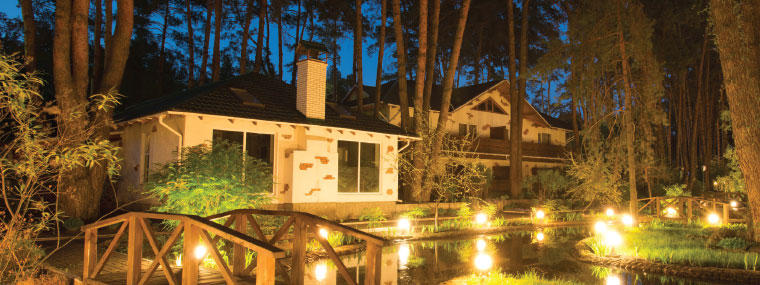
Florida Law: Restrictive Covenants
by Michael J. Gelfand, ESQ. / Published April 2015

“If good fences make good neighbors, what do your lights make?” This is how a Florida appellate court began a recent decision regarding a dispute between neighbors in a community over a yard lighting system. Leamer v. White, 40 Fla. L. Weekly D 283 (Fla. 1st DCA, January 27, 2015), addressed neighbor veto rights over exterior alterations. The setting was adjoining, luxury, waterfront townhouses with a shared common wall, a wall that apparently was not effective at keeping them apart, at least in court.
One neighbor installed landscape lighting without seeking approval of his community’s architectural review board mandated by a declaration of covenants. The covenant provided the following:
Ostentatious Site Features. The construction of ostentatious site features such as topiary, sculpture, free standing fountains in the foreground of townhouses, or lighting systems, which may be offensive to adjacent neighbors is unacceptable.
After the adjoining neighbor objected to the lighting, the installing neighbor then submitted an application for what was already installed.
In what may become a rallying cry for associations, the appellate court succinctly observed “Florida is perhaps ground zero in legal battles between homeowners associations and property owners over the interpretation and en-forceability of private restrictive covenants, which are commonly used in newer subdivisions, large developments, and condominium communities.”
The community’s architectural review board conditionally approved the lighting installation, but did not grant a complete approval because the board interpreted the covenant as allowing a neighbor to veto an installation and requiring written approval of the neighbor. The adjoining neighbor not only refused to consent to the lighting system, but instead sued the installing neighbor alleging that the lights were excessively bright. The trial court agreed that the covenant provided for a veto over any lighting system and granted judgment for the plaintiff—the adjoining neighbor.
The Florida appellate court disagreed and directed entry of judgment for the defendant—the installing neighbor. The court held that the covenants did not grant an owner the power to veto an adjacent neighbor’s lighting system.
In what may become a rallying cry for associations, the appellate court succinctly observed “Florida is perhaps ground zero in legal battles between homeowners associations and property owners over the interpretation and en-forceability of private restrictive covenants, which are commonly used in newer subdivisions, large developments, and condominium communities.”
Further, the court stated, “In a world without restrictive covenants, architectural review boards, and a court system, neighboring property owners such as the Leamers and Whites would have to resolve their disputes privately and cooperatively, a timeless and pervasive method by which order informally and sometimes spontaneously arises without resort to legal process.” Hopefully, the court did not mean a process involving a duel in the parking lot!
One lesson to consider as a result of this decision is whether to limit the weight of neighbor input into alteration decisions. Another lesson is the word choices in restrictions. It is important for an association to read carefully its restrictive covenants when it comes to approval of items such as landscaping or lighting to head off neighbor feuds. A restriction may need to be amended to clarify limitations. Usage may also change as circumstances change, requiring an amendment.
Restrictive Covenants: Grass Is Not Structural
Anyone who spends a summer here in South Florida knows how hard it can be to maintain a nicely manicured lawn. What happens when an owner decides to go grassless? Can an association veto that plan? Maybe not.
In another case involving landscaping, a Florida appellate court recently ruled that community covenants did not require association approval for non-structural changes to an owner’s lawn. In Bendo v. Silver Woods Community Association, Inc., 40 Fla. L. Weekly D 358 (Fla. 5th DCA, February 6, 2015), an owner’s front yard was destroyed after he installed a new septic drain field.
The association approved changes, which included a retaining wall, but rejected the owner’s landscape design because it did not include a grass lawn. The covenant provided as follows:
Approval of ARC. No building, fence, wall, or other structure shall be commenced, erected, or maintained upon the property, nor shall any ex-terior addition to or change or alteration therein be made, unless it is…approved in writing as to harmony of external design and location in relation to surrounding structures and topography by the board of directors of the association, or by the Architectural Review Committee (ARC).
The trial court concluded that the “plain” language of the covenant required association approval.
Noting that the interpretation of this provision leads to “an illogical result,” the Florida appellate court reversed the decision of the trial court. The appellate court, reading the covenant literally, held that this provision only requires approval for landscape designs that constitute an “exterior addition,” “change” or “alteration” to property, such as the retaining wall. The court pointed out that another provision of the declaration provided authority for the association to require owners to maintain their landscapes.
Thus, the bottom line of this decision is that the association did not have the authority to require an owner to have a grass lawn. It should be pointed out that the Florida Legislature has deemed this area important enough to prohibit homeowners’ associations from not allowing owners from implementing “Florida-friendly landscaping” as defined in Section 373.185, Fla. Stat. (2014). Florida-friendly landscaping is defined as quality landscapes that conserve water, protect the environment, are adaptable to local conditions, and are drought tolerant. In other words, if a homeowner wishes to have a grass-free lawn, the association may have a tough time preventing that choice.

